Home » Blog
News from the MFAH Photography Department from Curator Malcolm Daniel May, 2023
Posted on Jun 6, 2023
May 31, 2023
Dear Friends of the MFAH Photography Department,
It’s summer! It’s not the summer solstice yet, but with Memorial Day come and gone, it’s time to wear white again, walk the dog at 7:00 a.m. before the temperature gets above 90°, and turn our thoughts from end-of-season activities to planning for next year. But first, a recap of recent events.
The past month has been a momentous one. Our big event, of course, was Photo Forum Vote Night on May 8, with a full house, seven fun rounds of voting, and nearly everything acquired thanks to generous gifts in support of specific works in addition to the pool of funds from our dues. Winner of the first round—with extra encouragement in the form of pledges from Mary O’Hearn and Shelley Calton and Stuart Nelson—was Earlie Hudnall’s iconic Flipping Boy, which the Houston Chronicle recently described as “the definitive photograph of Houston.” This purchase marks the start of a concerted effort to build a stronger collection at MFAH of our most renowned hometown photographer, an effort continued in the weeks since Vote Night by the purchase of Hudnall’s The Guardian (thank you, Franci Neely!), a gift of Jewish Prayer Shawls (Tallit) from Joan Morgenstern, and Fourth of July, 4th Ward, Houston, TX as a gift of the artist. Vote Night round two brought in a gorgeous view of Venice from about 1860, and round three brought in Zana Briski’s extraordinary view of the world’s largest mammal migration—millions of straw-colored fruit bats rising from the forests of Zambia against the moon. The full list of Vote Night acquisitions is attached at the end of this letter. Thank you to all our Photo Forum members, to all who attended, and to all whose generosity has now allowed us to acquire everything that was presented.
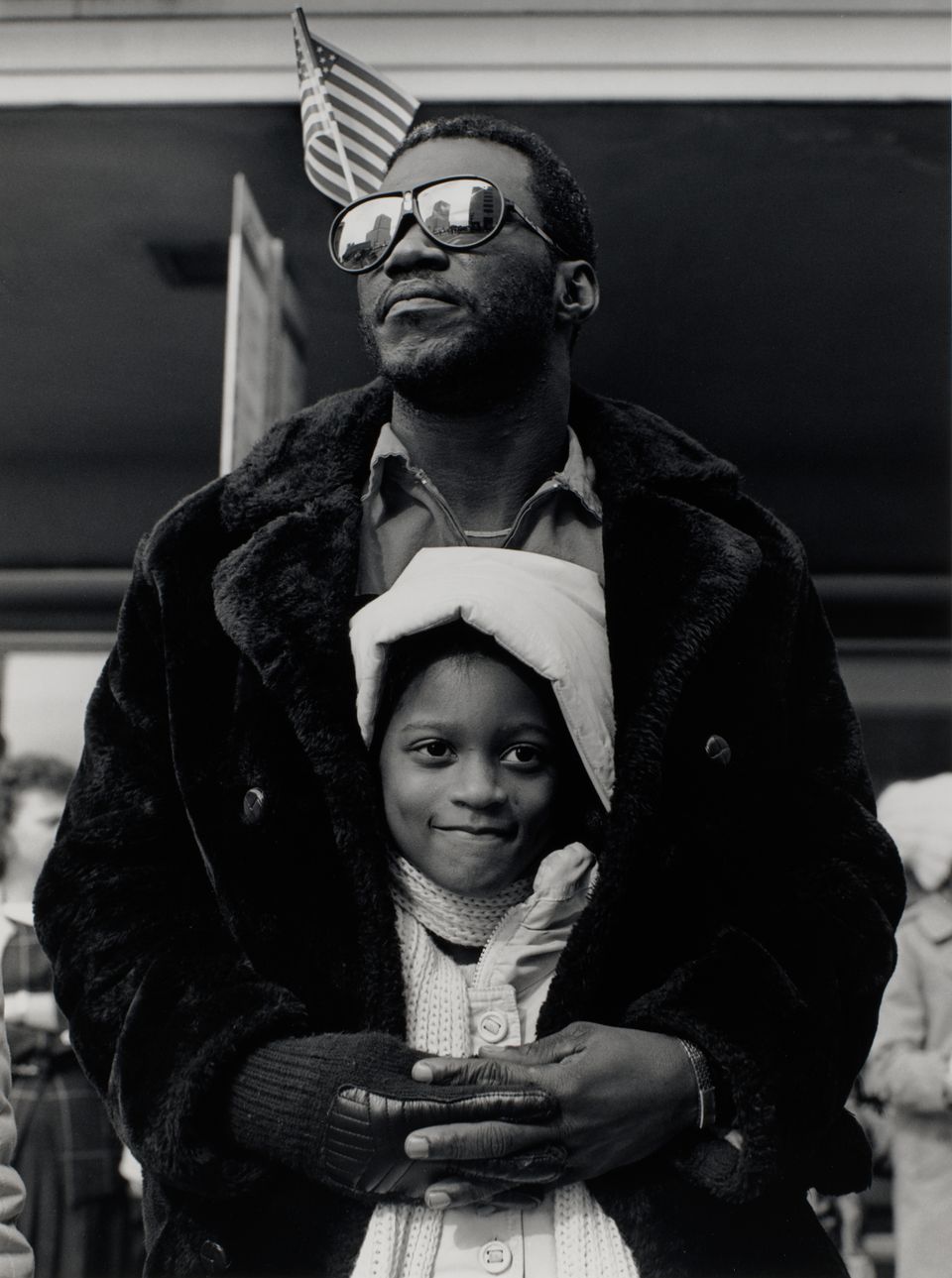
Earlie Hudnall, Jr. (American, born 1946), The Guardian, 1990.
Gelatin silver print, 18 5/8 × 13 15/16 in. (47.3 × 35.4 cm).
Museum purchase funded by Franci Neely, 2023.235
© Earlie Hudnall Jr.
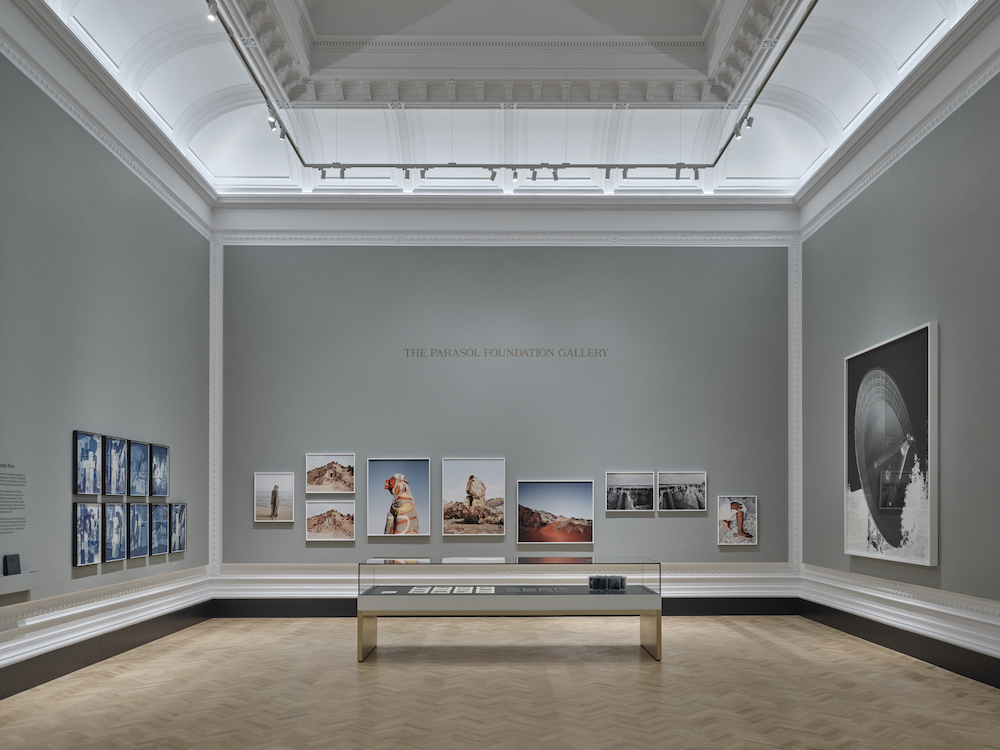
One of seven galleries that form the new Photography Centre at the Victoria and Albert Museum.
Photo Forum heads to London…
At Vote Night, I announced plans for Photo Forum’s first international trip, five days in London in early November, just before the Paris Photo fair. Highlights will include visits to the Victoria and Albert Museum’s new photography galleries with the V&A curators; Tate Modern with former MFAH curator Yasufumi Nakamori; the major Daido Moriyama show at The Photographers’ Gallery with Director Shoair Mavlian; prominent private collections including the Wilson Centre for Photography; and a day in Oxford with visits to the Bodleian Library, Ashmolean Museum, and Pitt Rivers Museum. All that plus good food, drink, and camaraderie. The trip is open only to Photo Forum members, with Founder and Benefactor members having first priority when registration opens. A more detailed itinerary and costs will be distributed soon. If you are interested, subject to final details of course, let Ashley Powell know now, at apowell@mfah.org.
1001 Bissonnet, Houston TX 77005 Tel: (713) 800-5389 P.O. Box 6826, Houston, TX 77265-6826 Fax: (713) 639-7399
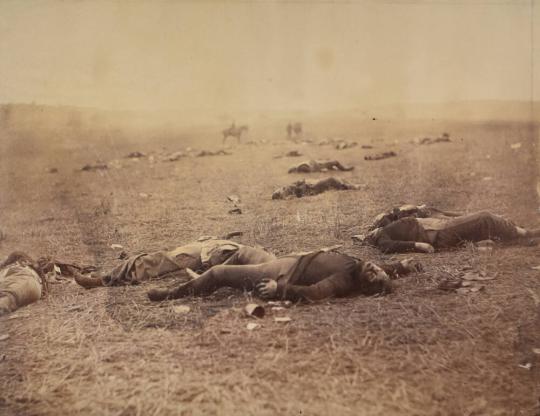
Timothy O’Sullivan (American, born Ireland, 1840-1882), Field Where General Reynolds Fell, Gettysburg, July 1863.
In Gardner's Photographic Sketch Book of the War, 1866.
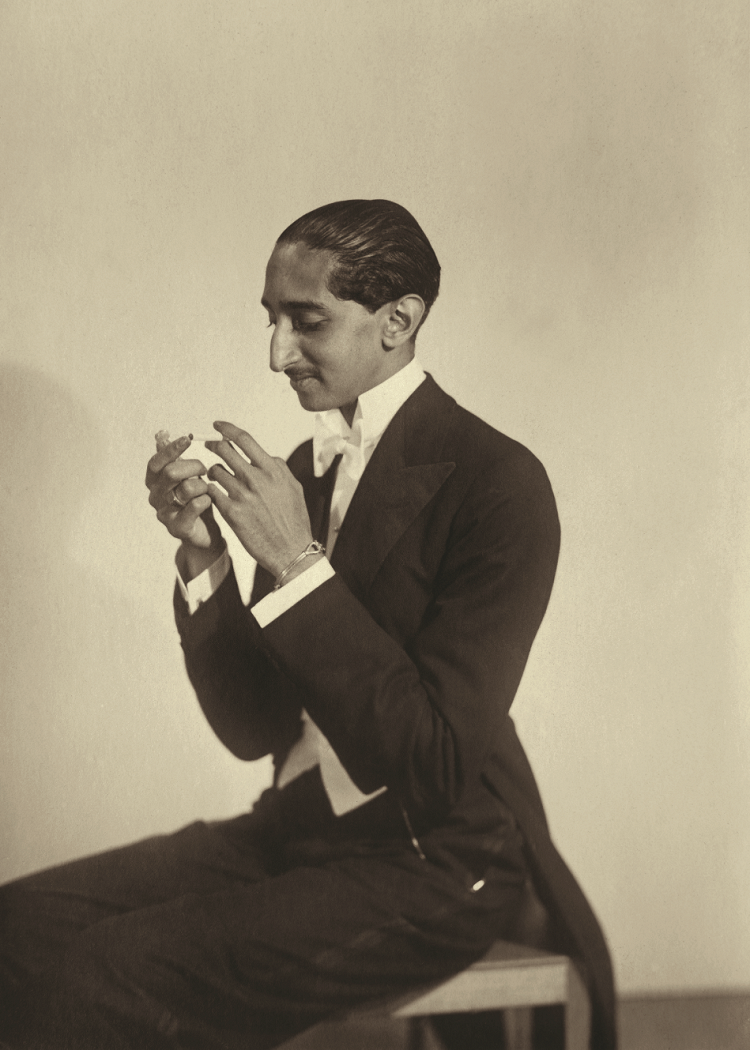
Man Ray (American, 1890-1976), The Maharaja of Indore, c. 1930.
Gelatin silver print, 9 × 6 13/16 in. (22.8 × 17.3 cm).
Museum purchase funded Caroline Wiess Law Accessions Endowment, 2023.229
© Man Ray 2015 Trust / Artists Rights Society (ARS), NY / ADAGP, Paris.
New acquisitions…
Vote Night was not the only venue for new acquisitions this past month. The Collections Committee of the Board also approved several important new purchases at their May meeting—one 19th-century, one 20th, and one 21st:
First is Alexander Gardner’s Photographic Sketch Book of the War, the most influential and iconic photographic record of the Civil War and arguably the most important photographically illustrated book published in America in the nineteenth century. With 100 tipped-in albumen silver prints by a dozen photographers, the beautifully bound two-volume set was a luxurious production, sold by subscription in 1866 for a whopping $150—the equivalent of $5,000 or $6,000 today. Among the most iconic images in the publication—and of the entire Civil War—are Timothy O’Sullivan’s photographs of the Gettysburg battlefield strewn with the dead, their shoes stripped for the living and their pockets turned inside out. “It was, indeed, a ‘harvest of death,’” wrote Gardner in the text accompanying one such picture. “Such a picture conveys a useful moral: It shows the blank horror and reality of war, in opposition to its pageantry. Here are the dreadful details! Let them aid in preventing such another calamity falling upon the nation." Even without our collection’s deep holdings of conflict-related photographs assembled in the lead-up to Anne Tucker’s monumental exhibition WAR/PHOTOGRAPHY (but especially with that focus), the Sketch Book is an essential title in our efforts to build a world-class collection of photographically illustrated books.
Next is Man Ray’s portrait of the 22-year-old Yeshwant Rao Holkar II, the 14th Maharaja of Indore, an elegant aesthete dressed in formal evening wear. While living in Paris from 1921 to 1940, Man Ray moved in the avant-garde world of artists and architects, composers and dancers, fashion designers and filmmakers, musicians and writers. He moved in Surrealist circles and produced paintings, sculptures, drawings, films, and photographs, often stretching the limits of his materials, but his primary activity and the means by which he supported himself was as a portrait photographer. The very young and fabulously wealthy Maharaja and his wife traveled in those same avant-garde circles, maintained a stable that was the envy of the racing world, bought the most exotic cars of the time, and collected and commissioned important works of modern art and design. This exquisite vintage print comes from the Maharaja’s descendants and was reserved for the MFAH by director Gary Tinterow at the TEFAF fair in Maastricht this spring.
And finally, we’ve acquired an expansive and marvelously engaging triptych, Jal, Jungal, Jameen, by Indian photographer Gauri Gill and Warli painter Rajesh Vangad. This is the most ambitious product of a decade-long collaboration in which Gill photographs Vangad in places of special meaning to him in the small farming village of Ganjad, about 75 miles north of Mumbai, and Vangad then draws directly on the prints, combining the contemporary language of photography with that of ancient Warli painting. Warli painting is a folk art handed down from generation to generation and originally created only by women, usually on mud walls in the village, to celebrate special occasions like weddings and festivals. Vangad’s uses the traditional language of circles, squares, and triangles to picture contemporary content. Jal, Jungal, Jameen, means “water, forest, land”—the three natural resources that have served indigenous populations of India for centuries—and Gill photographed Vangad by the river’s edge, amid trees, and standing in the fields. Vangad’s drawings, however, include not only fish, plant life, and farm dwellings, but also sinking tankers, fires, polluting factories, lines of trucks, paved roads, bullet trains, lumber mills, concrete buildings, and densely populated cities. The triptych, then, stands as a call to action against the environmental degradation, land encroachment, and exploitation that threaten India’s indigenous people and their traditions of life in harmony with the natural world.
Gauri Gill (Indian, born 1970) and Rajesh Vangad (Indian, born 1975), Jal, Jungal, Jameen, 2021.
From the series Fields of Sight. Inkjet prints with applied color, 42 × 62 in. (106.7 × 157.5 cm) each.
Caroline Wiess Law Accessions Endowment Fund, 2023.236.A-.C
©Gauri Gill and Rajesh Vangad.
Movie Night at MFAH…
The movie poster for Dancing the Twist in Bamako instantly grabbed my eye as being inspired by Malick Sidibé’s photograph Christmas Eve (99.223) and related sculptures by Coulibaly Siaka Paul (99.232-.233), which you saw in our 2020 exhibition “Through an African Lens: Sub-Saharan Photography from the Museum’s Collection.” The film, directed by Robert Guédiguian, is set in Mali in 1962. The youth of Bamako dance the twist to rock and roll music (newly imported from the West) and dream of political renewal. Samba, a young socialist, falls for spirited Lara during one of his missions to the bush. To escape her forced marriage, Lara secretly flees with Samba to the city. But Lara’s husband won’t let them be, and a revolution soon brings painful disillusions as they dream of a future together. The film plays Sunday, June 4, and Sunday June 11, at 5:00 p.m. in the Lynn Wyatt Theater. Click here for tickets.
It’s not photo-related, but I also call your attention to the Museum’s Jazz on Film series, always a crowd favorite, running June 9 to 24. Follow the link for details about the films being shown and for tickets.
Warmest wishes to you all for a cool summer,
Malcolm Daniel
Photographs purchased for the MFAH collection at Photo Forum Vote Night, May 8, 2023
Founded in 1988, Photo Forum supports the photography department and has made possible the acquisition of more than 500 photographs. Patrons gain access to the Museum’s curators and renowned collection through behind-the-scenes seminars, special tours and exhibition receptions, artist lectures, and visits to prominent private collections. Members at all levels are also entitled to cast ballots on works proposed for acquisition at the annual “Vote Night,” the celebratory climax of each year’s calendar. This ongoing program of activities provides an enriching experience for collectors and enthusiasts, and through their contributions, Photo Forum members help the Museum bring the very best of the art of photography to a broad public. For more information about Photo Forum, contact Ashley Powell at apowell@mfah.org or 713.639.7594.
Round 1 acquisition
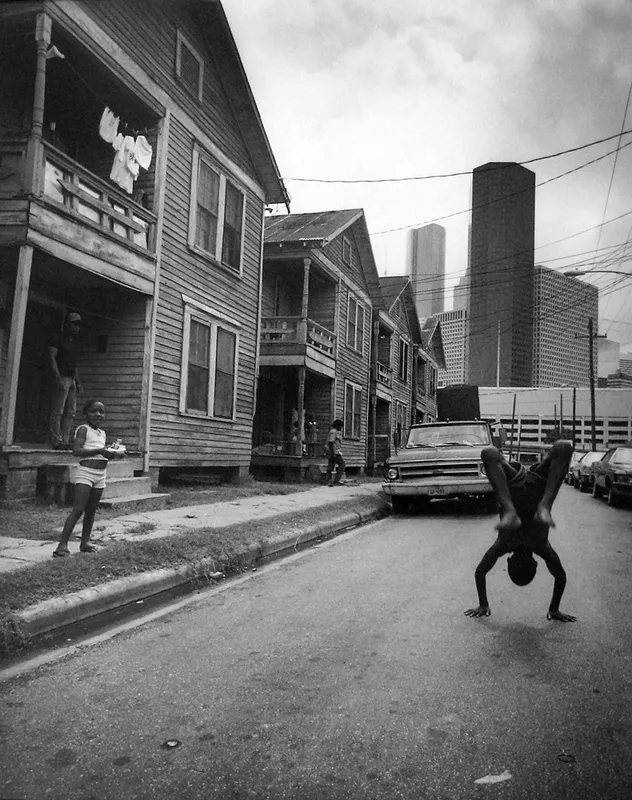
Earlie Hudnall, Flipping Boy 4th Ward, Houston, TX, 1983.
Museum purchase funded by Mary O’Hearn; Shelley Calton and Stuart Nelson; and Photo Forum 2023.
For the past 60 years, Hudnall has photographed his Houston community, celebrating the people and places that give this city its character. “There’s no place like one’s own backyard,” he said. In Flipping Boy, two worlds are in opposition—the traditionally African American neighborhood of Houston’s 4th Ward and the exploding downtown real estate development that threatened to overtake it.
Round 2 acquisition
Attributed to Domenico Bresolin, [Rio de la Canonica with the Bridge of Sighs, Venice], 1860.
Museum purchase funded by Photo Forum 2023 and John S. and Nancy Nolan Parsley in honor of Ulisse Marinoni.
Recorded with crystalline clarity and sumptuously printed, this large and stunning picture is likely the work of Domenico Bresolin, best known as a painter of vedute, Venetian cityscapes. Spanning the canal in the distance but out of reach, is one of the city’s most famous sights: the exquisite Bridge of Sighs, built in 1600 to connect the courtrooms of the Doge’s Palace and the prison.
Round 3 acquisition
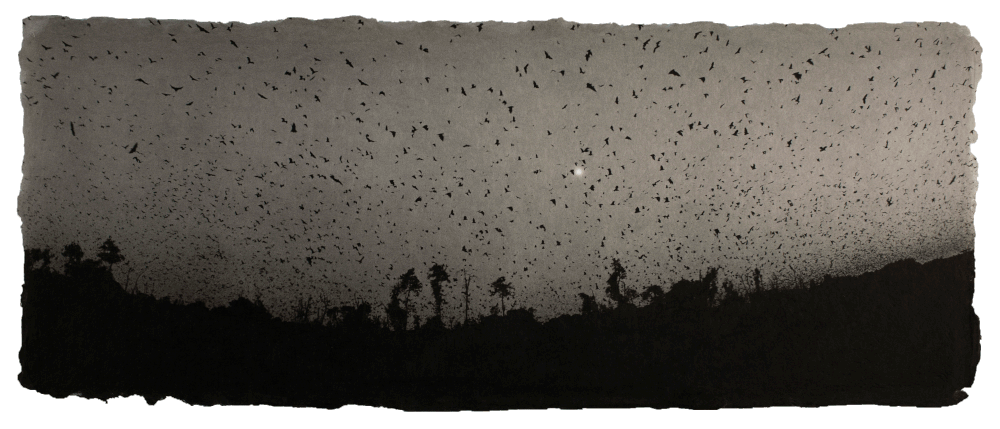
Zana Briski, Straw-Colored Fruit Bat Migration, Zambia, 2015.
Museum purchase funded by Photo Forum 2023 and Joan Morgenstern.
Long enthralled by the natural world, noted photographer and filmmaker Zana Briski has traveled the globe to photograph wonders of the animal kingdom. Here, she photographed the largest mammal migration on the planet, when 8 million straw-colored fruit bats descend on a tiny patch of the Kasanka National Park in Zambia from as far as a thousand kilometers away and rise from the trees each evening against the moon.
Round 4 acquisition
Andre Giroux, House by a River, c. 1855. Museum purchase funded by
Photo Forum 2023 and Patricia Eifel and James Belli.
Giroux was a painter by training and temperament, and this image of rustic stone cottages
nestled in the scenic French countryside embodies the aesthetic traditions of
painting as filtered through the camera.
Round 5 acquisition
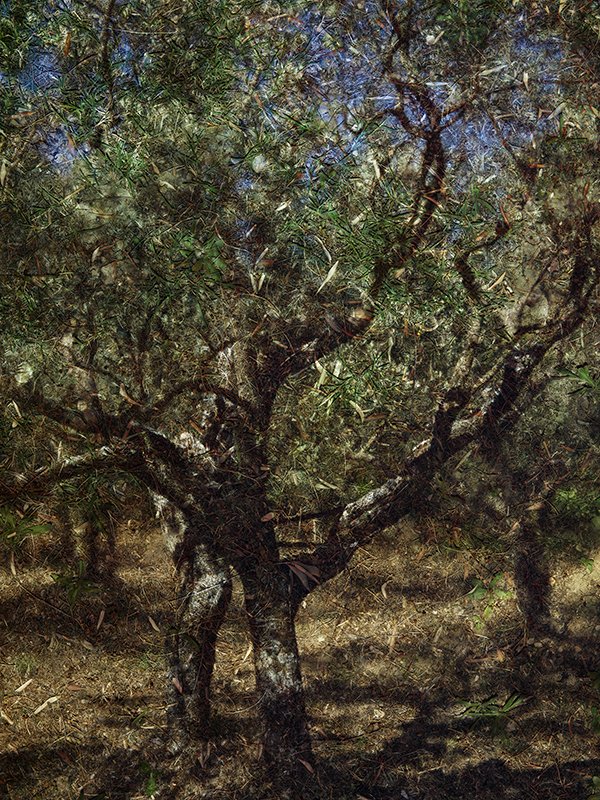
Abelardo Morell, Tent-Camera Image on Ground: Olive Tree #2, St-Remy de Provence, France, 2022.
Museum purchase funded by Photo Forum 2023.
Abe Morell has found a way to take his signature technique out into the landscape. If one mistook this photograph for a painting, one would be forgiven. Using a light-tight portable tent as a camera obscura, Morell superimposed the bucolic scenes observed by 19th-century artists he admires onto the muddy fields and dry grass on which they stood.
Museum purchase funded by Photo Forum 2023 and Joan Morgenstern.
Round 6 acquisition
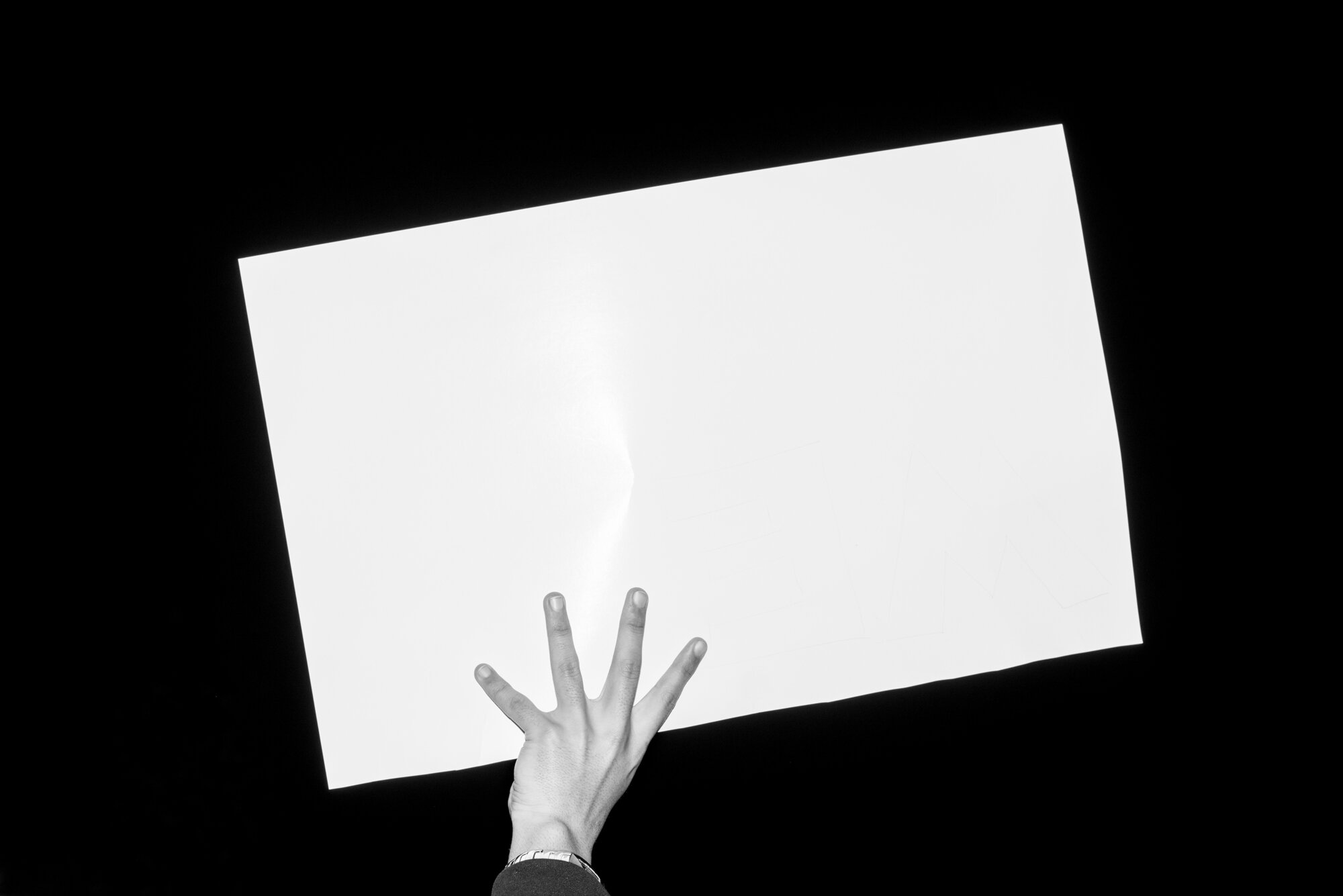
Mike Osborne, White House/1600 Pennsylvania Ave NW, 2019.
Museum purchase funded by Photo Forum 2023 and Barbara and James Hemphill.
Pictures from Mike Osborne’s Federal Triangle series depict an area of Washington, D.C., where a nonstop stream of elusive events and encounters play out. While his photographs suggest specific occurrences, key contextual details remain out-of-frame or unphotographed, opening them up, Osborne says, “to projections that speak to the fear, doubt, dysfunction, and absurdity of the current moment in American political life.”
Round 7 acquisition
Armando Salas Portugal, Uxmal, Yucatan, 1962.
Museum purchase funded by Photo Forum 2023 and Joan Morgenstern.
Armando Salas Portugal photographed the landscape of his native Mexico and its architecture, from Mayan ruins to the modernist constructions of Luis Barragán. In this surprisingly large and delicately hand-colored view of the so-called Nunnery at Uxmal, Salas Portugal imbued his picture with a Romantic sense of lost civilization.
Individually funded works
Kati Horna, Interior of the Torre de Automex, Toluca, (arch. M. Goeritz), 1964.
Museum purchase funded by Morris Weiner.
This striking architectural abstraction depicts the interior of a tower designed by Mathias Goeritz at the Auto-Mex Factory, Mexico’s first large scale car factory and a symbol of economic and political progress. Horna’s straightforward exterior views of the factory complex circulated in contemporary publications, but here Horna appears more intent on creating her own boldly modernist image.
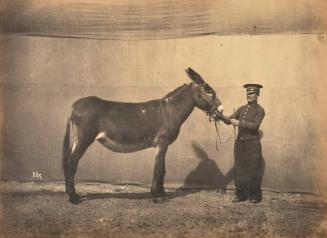
Adrien Tournachon, Catharina, 1858.
Museum purchase funded in honor of Lisa Volpe by Joan Morgenstern; Tim Linehan and Carol Strawn; Krista and Michael Dumas; and Aimée and Donald McCrory.
Adrien Tournachon, brother of the famous Nadar, photographed prizewinning animals at the French national agricultural competitions in the late 1850s and early 1860s. Such photographs were intended to serve artists and breeders alike as records of particularly fine specimens and as souvenirs of rural life.
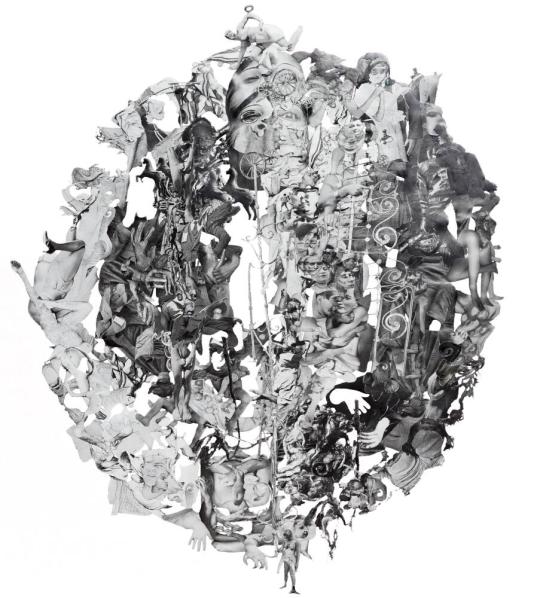
Justine Kurland, The Early Work (Excerpt), 2022.
Museum purchase funded by the Francis L. Lederer Foundation, courtesy of Sharon Lederer; Nena Marsh; Tania Pramir; and Rashed Haq in honor of Tayyba Kanwal.
This collage, formed entirely of images cut from a MoMA catalogue of Henri Cartier-Bresson’s early work, is part of a series the artist describes as “comprising the destruction of my personal library of canonized white male photographers—men I was taught to revere, whose conventions I was meant to uphold; men who have taken up too much room psychically and physically. Each collage is made from a single book.”
News from the MFAH Photography Department from Curator Malcolm Daniel May, 2023
Posted on Jun 6, 2023
May 31, 2023
Dear Friends of the MFAH Photography Department,
It’s summer! It’s not the summer solstice yet, but with Memorial Day come and gone, it’s time to wear white again, walk the dog at 7:00 a.m. before the temperature gets above 90°, and turn our thoughts from end-of-season activities to planning for next year. But first, a recap of recent events.
The past month has been a momentous one. Our big event, of course, was Photo Forum Vote Night on May 8, with a full house, seven fun rounds of voting, and nearly everything acquired thanks to generous gifts in support of specific works in addition to the pool of funds from our dues. Winner of the first round—with extra encouragement in the form of pledges from Mary O’Hearn and Shelley Calton and Stuart Nelson—was Earlie Hudnall’s iconic Flipping Boy, which the Houston Chronicle recently described as “the definitive photograph of Houston.” This purchase marks the start of a concerted effort to build a stronger collection at MFAH of our most renowned hometown photographer, an effort continued in the weeks since Vote Night by the purchase of Hudnall’s The Guardian (thank you, Franci Neely!), a gift of Jewish Prayer Shawls (Tallit) from Joan Morgenstern, and Fourth of July, 4th Ward, Houston, TX as a gift of the artist. Vote Night round two brought in a gorgeous view of Venice from about 1860, and round three brought in Zana Briski’s extraordinary view of the world’s largest mammal migration—millions of straw-colored fruit bats rising from the forests of Zambia against the moon. The full list of Vote Night acquisitions is attached at the end of this letter. Thank you to all our Photo Forum members, to all who attended, and to all whose generosity has now allowed us to acquire everything that was presented.

Earlie Hudnall, Jr. (American, born 1946), The Guardian, 1990.
Gelatin silver print, 18 5/8 × 13 15/16 in. (47.3 × 35.4 cm).
Museum purchase funded by Franci Neely, 2023.235
© Earlie Hudnall Jr.

One of seven galleries that form the new Photography Centre at the Victoria and Albert Museum.
Photo Forum heads to London…
At Vote Night, I announced plans for Photo Forum’s first international trip, five days in London in early November, just before the Paris Photo fair. Highlights will include visits to the Victoria and Albert Museum’s new photography galleries with the V&A curators; Tate Modern with former MFAH curator Yasufumi Nakamori; the major Daido Moriyama show at The Photographers’ Gallery with Director Shoair Mavlian; prominent private collections including the Wilson Centre for Photography; and a day in Oxford with visits to the Bodleian Library, Ashmolean Museum, and Pitt Rivers Museum. All that plus good food, drink, and camaraderie. The trip is open only to Photo Forum members, with Founder and Benefactor members having first priority when registration opens. A more detailed itinerary and costs will be distributed soon. If you are interested, subject to final details of course, let Ashley Powell know now, at apowell@mfah.org.
1001 Bissonnet, Houston TX 77005 Tel: (713) 800-5389 P.O. Box 6826, Houston, TX 77265-6826 Fax: (713) 639-7399

Timothy O’Sullivan (American, born Ireland, 1840-1882), Field Where General Reynolds Fell, Gettysburg, July 1863.
In Gardner's Photographic Sketch Book of the War, 1866.

Man Ray (American, 1890-1976), The Maharaja of Indore, c. 1930.
Gelatin silver print, 9 × 6 13/16 in. (22.8 × 17.3 cm).
Museum purchase funded Caroline Wiess Law Accessions Endowment, 2023.229
© Man Ray 2015 Trust / Artists Rights Society (ARS), NY / ADAGP, Paris.
New acquisitions…
Vote Night was not the only venue for new acquisitions this past month. The Collections Committee of the Board also approved several important new purchases at their May meeting—one 19th-century, one 20th, and one 21st:
First is Alexander Gardner’s Photographic Sketch Book of the War, the most influential and iconic photographic record of the Civil War and arguably the most important photographically illustrated book published in America in the nineteenth century. With 100 tipped-in albumen silver prints by a dozen photographers, the beautifully bound two-volume set was a luxurious production, sold by subscription in 1866 for a whopping $150—the equivalent of $5,000 or $6,000 today. Among the most iconic images in the publication—and of the entire Civil War—are Timothy O’Sullivan’s photographs of the Gettysburg battlefield strewn with the dead, their shoes stripped for the living and their pockets turned inside out. “It was, indeed, a ‘harvest of death,’” wrote Gardner in the text accompanying one such picture. “Such a picture conveys a useful moral: It shows the blank horror and reality of war, in opposition to its pageantry. Here are the dreadful details! Let them aid in preventing such another calamity falling upon the nation." Even without our collection’s deep holdings of conflict-related photographs assembled in the lead-up to Anne Tucker’s monumental exhibition WAR/PHOTOGRAPHY (but especially with that focus), the Sketch Book is an essential title in our efforts to build a world-class collection of photographically illustrated books.
Next is Man Ray’s portrait of the 22-year-old Yeshwant Rao Holkar II, the 14th Maharaja of Indore, an elegant aesthete dressed in formal evening wear. While living in Paris from 1921 to 1940, Man Ray moved in the avant-garde world of artists and architects, composers and dancers, fashion designers and filmmakers, musicians and writers. He moved in Surrealist circles and produced paintings, sculptures, drawings, films, and photographs, often stretching the limits of his materials, but his primary activity and the means by which he supported himself was as a portrait photographer. The very young and fabulously wealthy Maharaja and his wife traveled in those same avant-garde circles, maintained a stable that was the envy of the racing world, bought the most exotic cars of the time, and collected and commissioned important works of modern art and design. This exquisite vintage print comes from the Maharaja’s descendants and was reserved for the MFAH by director Gary Tinterow at the TEFAF fair in Maastricht this spring.
And finally, we’ve acquired an expansive and marvelously engaging triptych, Jal, Jungal, Jameen, by Indian photographer Gauri Gill and Warli painter Rajesh Vangad. This is the most ambitious product of a decade-long collaboration in which Gill photographs Vangad in places of special meaning to him in the small farming village of Ganjad, about 75 miles north of Mumbai, and Vangad then draws directly on the prints, combining the contemporary language of photography with that of ancient Warli painting. Warli painting is a folk art handed down from generation to generation and originally created only by women, usually on mud walls in the village, to celebrate special occasions like weddings and festivals. Vangad’s uses the traditional language of circles, squares, and triangles to picture contemporary content. Jal, Jungal, Jameen, means “water, forest, land”—the three natural resources that have served indigenous populations of India for centuries—and Gill photographed Vangad by the river’s edge, amid trees, and standing in the fields. Vangad’s drawings, however, include not only fish, plant life, and farm dwellings, but also sinking tankers, fires, polluting factories, lines of trucks, paved roads, bullet trains, lumber mills, concrete buildings, and densely populated cities. The triptych, then, stands as a call to action against the environmental degradation, land encroachment, and exploitation that threaten India’s indigenous people and their traditions of life in harmony with the natural world.
Gauri Gill (Indian, born 1970) and Rajesh Vangad (Indian, born 1975), Jal, Jungal, Jameen, 2021.
From the series Fields of Sight. Inkjet prints with applied color, 42 × 62 in. (106.7 × 157.5 cm) each.
Caroline Wiess Law Accessions Endowment Fund, 2023.236.A-.C
©Gauri Gill and Rajesh Vangad.
Movie Night at MFAH…
The movie poster for Dancing the Twist in Bamako instantly grabbed my eye as being inspired by Malick Sidibé’s photograph Christmas Eve (99.223) and related sculptures by Coulibaly Siaka Paul (99.232-.233), which you saw in our 2020 exhibition “Through an African Lens: Sub-Saharan Photography from the Museum’s Collection.” The film, directed by Robert Guédiguian, is set in Mali in 1962. The youth of Bamako dance the twist to rock and roll music (newly imported from the West) and dream of political renewal. Samba, a young socialist, falls for spirited Lara during one of his missions to the bush. To escape her forced marriage, Lara secretly flees with Samba to the city. But Lara’s husband won’t let them be, and a revolution soon brings painful disillusions as they dream of a future together. The film plays Sunday, June 4, and Sunday June 11, at 5:00 p.m. in the Lynn Wyatt Theater. Click here for tickets.
It’s not photo-related, but I also call your attention to the Museum’s Jazz on Film series, always a crowd favorite, running June 9 to 24. Follow the link for details about the films being shown and for tickets.
Warmest wishes to you all for a cool summer,
Malcolm Daniel
Photographs purchased for the MFAH collection at Photo Forum Vote Night, May 8, 2023
Founded in 1988, Photo Forum supports the photography department and has made possible the acquisition of more than 500 photographs. Patrons gain access to the Museum’s curators and renowned collection through behind-the-scenes seminars, special tours and exhibition receptions, artist lectures, and visits to prominent private collections. Members at all levels are also entitled to cast ballots on works proposed for acquisition at the annual “Vote Night,” the celebratory climax of each year’s calendar. This ongoing program of activities provides an enriching experience for collectors and enthusiasts, and through their contributions, Photo Forum members help the Museum bring the very best of the art of photography to a broad public. For more information about Photo Forum, contact Ashley Powell at apowell@mfah.org or 713.639.7594.
Round 1 acquisition

Earlie Hudnall, Flipping Boy 4th Ward, Houston, TX, 1983.
Museum purchase funded by Mary O’Hearn; Shelley Calton and Stuart Nelson; and Photo Forum 2023.
For the past 60 years, Hudnall has photographed his Houston community, celebrating the people and places that give this city its character. “There’s no place like one’s own backyard,” he said. In Flipping Boy, two worlds are in opposition—the traditionally African American neighborhood of Houston’s 4th Ward and the exploding downtown real estate development that threatened to overtake it.
Round 2 acquisition
Attributed to Domenico Bresolin, [Rio de la Canonica with the Bridge of Sighs, Venice], 1860.
Museum purchase funded by Photo Forum 2023 and John S. and Nancy Nolan Parsley in honor of Ulisse Marinoni.
Recorded with crystalline clarity and sumptuously printed, this large and stunning picture is likely the work of Domenico Bresolin, best known as a painter of vedute, Venetian cityscapes. Spanning the canal in the distance but out of reach, is one of the city’s most famous sights: the exquisite Bridge of Sighs, built in 1600 to connect the courtrooms of the Doge’s Palace and the prison.
Round 3 acquisition

Zana Briski, Straw-Colored Fruit Bat Migration, Zambia, 2015.
Museum purchase funded by Photo Forum 2023 and Joan Morgenstern.
Long enthralled by the natural world, noted photographer and filmmaker Zana Briski has traveled the globe to photograph wonders of the animal kingdom. Here, she photographed the largest mammal migration on the planet, when 8 million straw-colored fruit bats descend on a tiny patch of the Kasanka National Park in Zambia from as far as a thousand kilometers away and rise from the trees each evening against the moon.
Round 4 acquisition
Andre Giroux, House by a River, c. 1855. Museum purchase funded by
Photo Forum 2023 and Patricia Eifel and James Belli.
Giroux was a painter by training and temperament, and this image of rustic stone cottages
nestled in the scenic French countryside embodies the aesthetic traditions of
painting as filtered through the camera.
Round 5 acquisition

Abelardo Morell, Tent-Camera Image on Ground: Olive Tree #2, St-Remy de Provence, France, 2022.
Museum purchase funded by Photo Forum 2023.
Abe Morell has found a way to take his signature technique out into the landscape. If one mistook this photograph for a painting, one would be forgiven. Using a light-tight portable tent as a camera obscura, Morell superimposed the bucolic scenes observed by 19th-century artists he admires onto the muddy fields and dry grass on which they stood.
Museum purchase funded by Photo Forum 2023 and Joan Morgenstern.
Round 6 acquisition

Mike Osborne, White House/1600 Pennsylvania Ave NW, 2019.
Museum purchase funded by Photo Forum 2023 and Barbara and James Hemphill.
Pictures from Mike Osborne’s Federal Triangle series depict an area of Washington, D.C., where a nonstop stream of elusive events and encounters play out. While his photographs suggest specific occurrences, key contextual details remain out-of-frame or unphotographed, opening them up, Osborne says, “to projections that speak to the fear, doubt, dysfunction, and absurdity of the current moment in American political life.”
Round 7 acquisition
Armando Salas Portugal, Uxmal, Yucatan, 1962.
Museum purchase funded by Photo Forum 2023 and Joan Morgenstern.
Armando Salas Portugal photographed the landscape of his native Mexico and its architecture, from Mayan ruins to the modernist constructions of Luis Barragán. In this surprisingly large and delicately hand-colored view of the so-called Nunnery at Uxmal, Salas Portugal imbued his picture with a Romantic sense of lost civilization.
Individually funded works
Kati Horna, Interior of the Torre de Automex, Toluca, (arch. M. Goeritz), 1964.
Museum purchase funded by Morris Weiner.
This striking architectural abstraction depicts the interior of a tower designed by Mathias Goeritz at the Auto-Mex Factory, Mexico’s first large scale car factory and a symbol of economic and political progress. Horna’s straightforward exterior views of the factory complex circulated in contemporary publications, but here Horna appears more intent on creating her own boldly modernist image.

Adrien Tournachon, Catharina, 1858.
Museum purchase funded in honor of Lisa Volpe by Joan Morgenstern; Tim Linehan and Carol Strawn; Krista and Michael Dumas; and Aimée and Donald McCrory.
Adrien Tournachon, brother of the famous Nadar, photographed prizewinning animals at the French national agricultural competitions in the late 1850s and early 1860s. Such photographs were intended to serve artists and breeders alike as records of particularly fine specimens and as souvenirs of rural life.

Justine Kurland, The Early Work (Excerpt), 2022.
Museum purchase funded by the Francis L. Lederer Foundation, courtesy of Sharon Lederer; Nena Marsh; Tania Pramir; and Rashed Haq in honor of Tayyba Kanwal.
This collage, formed entirely of images cut from a MoMA catalogue of Henri Cartier-Bresson’s early work, is part of a series the artist describes as “comprising the destruction of my personal library of canonized white male photographers—men I was taught to revere, whose conventions I was meant to uphold; men who have taken up too much room psychically and physically. Each collage is made from a single book.”


Comments (0)
Add a Comment